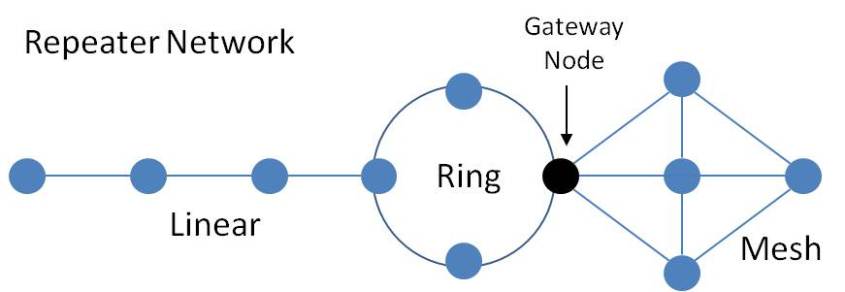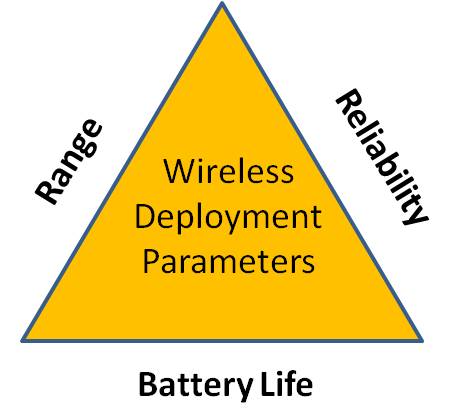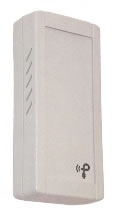|
March 2012
Article
AutomatedBuildings.com
|
[an error occurred while processing this directive]
(Click
Message to Learn More)
|
Deploying a
High-Performance Wireless Monitoring and Control Network
A
reliable wireless system
should be able to transmit data through various types of building
materials, tolerate interference from other devices, and recover from
disruption to the network.
|
|
Much has been
written about the benefits of wireless technology for
building automation, HVAC control, and energy management. Over
the past several years, wireless technology has improved greatly in
terms of performance and lower power consumption. Product
innovations have also accelerated as regulatory certification has
become less burdensome with the FCC’s approval of
pre-certified wireless modules.
The most obvious benefits of wireless solutions are rapid deployment
and low installation costs, especially for retrofit applications where
wiring is prohibitively expensive. Facilities constructed with
lots of concrete block (e.g. K-12 schools), with asbestos, or projects
where running conduit is required, are all great candidates for using
wireless technology to reduce costs. Wireless is also a great
solution where installation is time sensitive or where occupant
disruption has to be kept to a minimum.
Wireless Applications
Wireless
can be used for a wide range of applications from simple
point-to-point links to a facility-wide network, for real-time control
or just monitoring and data logging. Example wireless sensors
include temperature, humidity, light level, differential pressure and
pulse meters. And new, low-power wireless CO2 sensors are now
enabling rapid wireless retrofits for demand-controlled ventilation
(DCV). DCV can deliver substantial energy savings with a
relatively short payback timeframe, as documented in a study by the US.
Department of Energy. A wireless solution makes DCV
implementation faster and easier than wiring.
Temporary data logging is an often-overlooked wireless application,
such as during an energy service company (ESCO) pre-investment
audit. In this case, wireless data logging with the ability to
push sensor data to the cloud in real-time, is far more useful and cost
effective than repeated trips to collect data loggers, download their
data, and redeploy them. Instead, ESCOs can use a wireless system
for pre-investment audits, and then leave it in place for monitoring
during the life of the performance contract.
Wireless Technology and Robust
Performance
The
three most important considerations when designing and deploying
wireless-based professional HVAC and energy-management systems are:
battery life, range, and reliability (see Figure 1).
Figure
1: Key wireless deployment parameters
Battery
Life
Wireless devices with short battery life result in higher maintenance
costs and potentially reduced system efficiency, with subsequent lost
energy savings, when such devices fall out of the network because their
batteries aren’t replaced. Many wireless sensors on the market
today are specified with 3-5 years of battery life, though some systems
may reach 7 years if they’re configured for longer sampling
periods. Over time, the repeated cost of battery replacement
negates the benefits of wireless technology, and even limits the scale
to which facility managers are willing to deploy a wireless system.
One solution to the problems surrounding batteries is to harvest energy
from other sources, such as solar or artificial light, to create a
perpetual power source. The challenge is that indoor solar harvesting
is not reliable in all scenarios because it is an intermittent energy
source, and not available in places that receive no light. HVAC
system designers and facility operators need sensors to provide
reliable data all the time, not just intermittently when a device
receives harvested power. Adding a battery improves performance,
but rechargeable batteries do not have the same operating life as
high-quality primary batteries.
Consider a battery-based system that could operate for 25 years or
more, sending data every minute. This kind of system would provide more
reliable performance than one based on indoor light harvesting, and
would eliminate the issue of battery replacement, because the control
system is likely to be replaced before the battery is depleted.
Range
Range can impact both system cost and battery life. Lower
frequencies, higher transmission power, repeaters, and none-to-node
meshing are various techniques used to extend range. Some
component manufacturers and system providers promote various flavors of
mesh protocols as a way to extend range, by having data hop from one
sensor node to another until it reaches the destination gateway.
There are benefits to this approach, but they come at the expense of
latency and battery life. For example, the data from a sensor
node that is five hops from a gateway will take 5 minutes to get there
if each node wakes up and listens for data once per minute.
Listening for data from another node is an expensive use of finite
battery energy. Applications requiring real-time, or near
real-time performance may not be able to tolerate this type of
delay. For HVAC control, such a delay means greater swings in
environmental conditions which impacts occupant comfort, and reduced
system efficiency leading to higher energy consumption.
Line-powered repeaters can forward data in real-time, which is a better
approach to extending range in commercial building control
applications. Repeaters are easily installed in utility closets
and require minimal configuration. Repeaters should be capable of
extending range to unlimited distance and form a network of various
topologies including linear, ring, and mesh (see Figure 2). A
repeater network maximizes the network’s range while preserving battery
life of the sensor devices. Repeaters that use smart forwarding
techniques will not forward duplicate packets from multiple sources and
thereby reduce the overall amount of network traffic, which also
improves wireless performance.

Figure
2: A repeater network links various topologies (linear, ring and mesh)
to extend range.
Reliability
Reliability, or the ability of wireless transmissions to reach their
intended destination, is critical. A reliable wireless system
should be able to transmit data through various types of building
materials, tolerate interference from other devices, and recover from
disruption to the network. Lower frequencies propagate through
building materials better than higher frequencies, and users can employ
various modulation and frequency agility mechanisms to minimize or
overcome the effects of interference. Some systems simply
increase the transmission power to force the signal through, but this
solution potentially interferes with other signals, and also reduces
battery life.
[an error occurred while processing this directive]
An alternative to achieve reliable signal performance is to combine
both robust modulation and frequency agility. From a wireless
network perspective, using a line-powered repeater network in a mesh or
ring configuration enables multiple paths back to the gateway. A
properly-designed repeater network is inherently self-healing in the
event of a disruption. Additionally, implementing multiple
wireless gateways such that redundant gateways can receive the same
information enhances overall system performance. These gateways
can be in different areas, fed by different power circuits, and
connected to different network routers. In the event of a
failure, the control system can switch over to the backup gateway.
Example Wireless Sensor System for
HVAC, Building & Industrial Automation
Powercast
has developed a wireless sensor system intended to provide
good range, link and system-level reliability, and the longest battery
life available in the building controls industry. The company’s
goal was to provide the convenience and flexibility of wireless with
the predictability and longevity of wired solutions. The
Powercast Lifetime Power Wireless Sensor System offers:
•
25+ year battery life – using proven battery technology and
transmitting at one-minute internals
• Long range –
including unlimited network range, and real-time network performance
• High reliability –
supports frequency agility, self-forming/healing network, and redundancy
Wireless Sensors
Most wireless sensors for our system are available in small,
4”x2”x1” enclosures and are suitable for wall-mounting in commercial
office buildings (see Figure 3). They can be configured off-site
and deployed rapidly on-site. Sensor types include:
•
Temperature
• Humidity
• Light level
• External
temperature probes
• External dry
contacts
• Carbon dioxide
(CO2) – self calibrating
• Differential
pressure
Figure
3: Sensors come in small, 4”x2”x1” enclosures suitable for
wall-mounting.
We
designed our wireless sensors for very low power consumption,
which results in their ultra-long battery life. We have also
performed several simulated, worst-case, accelerated battery life tests
which confirmed operation for longer than 25 years. The company has
produced a test report (free download) to document the test
procedure
and results.
Wireless
Gateway
Supports up to 100 devices and connects to any BAS or IT system
using standard protocols including BACnet, Modbus, LonWorks, Metasys
N2, SNMP, XML, and more. Also supports data logging to a local PC
or connectivity to the cloud for remote monitoring.
Wireless
Repeaters
Support linear, mesh, ring, or hybrid topologies with real-time
latency performance. The repeater network is inherently
self-forming, self-healing, and capable of unlimited hops.
More information is available at www.PowercastSensors.com
About the Author
Harry Ostaffe is vice president of marketing and sales at Powercast
Corporation, and has over 23 years experience in the fields of
broadband and wireless networking, industrial controls, and computing
through various management and engineering positions at Ericsson,
Marconi, Lucent Technologies, AT&T Network Systems, Bayer and
IBM. Harry received an MBA from Carnegie Mellon University and a
B.S. in Electrical Engineering from Penn State University.
www.LinkedIn.com/in/HarryOstaffe
footer
[an error occurred while processing this directive]
[Click Banner To Learn More]
[Home Page] [The
Automator] [About] [Subscribe
] [Contact
Us]



